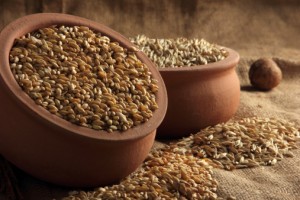
Poison ivy is one of the most commonly found plants in North America. Contact with the plant oils, either directly or indirectly, can cause an itchy, blistering rash. Watch out for plants that have three small leaflets on each leaf. This is usually a sign of poison ivy, poison sumac or poison oak. Poison ivy grows as a vine or a shrub, sprouting yellow-green flowers in the spring and green berries that turn off-white in early fall. Touching any part of the plant, including the roots, can cause an allergic reaction.
The best way to treat a poison ivy rash is to not get one in the first place. Make sure to wear long pants, long sleeves, boots, and gloves. Protect your skin by using an ivy block barrier lotion before going outdoors. Available over-the-counter, the lotion will help prevent the skin from absorbing the oil which causes the rash. Even with the ivy block, you still need to cover your skin. Touching anything that has the plant oil on it can cause an allergic reaction, including gardening tools, sporting equipment, shoes, and even a pet’s fur. Burning these plants releases the oil into the air and you can have an allergic reaction if airborne particles land on your skin.
According to the American Academy of Dermatology, most people can safely treat the rash at home. If you’ve been exposed, immediately do the following:
. Rinse your skin with lukewarm, soapy water.
. Thoroughly wash all of the clothes you were wearing when you came into contact with the plant.
. Wash everything that may have the oil on its surface in warm, soapy water including gardening tools, golf clubs, leashes and even your pet.
. Leave blisters alone and don’t scratch to avoid an infection.
. Take short, lukewarm baths in a colloidal oatmeal to ease the itch, or apply cool compresses.
. Apply calamine lotion to skin that itches. Hydrocortisone cream or lotion may also help.
. Antihistamine pills can help reduce itching, ask your doctor or pharmacist which one is best for you.
If you experience any of the following symptoms, go to the emergency room right away:
. Trouble breathing or swallowing.
. The rash and blisters cover most of your body and nothing eases the itch.
. You experience swelling, especially if an eyelid swells shut.
. The rash develops anywhere on your face or genitals.
If your rash is not improving after seven to ten days, or you think your rash may be infected, see a board-certified dermatologist. A dermatologist can treat your rash and any infection and help relieve the itch.
All content of this newsletter is intended for general information purposes only and is not intended or implied to be a substitute for professional medical advice, diagnosis or treatment. Please consult a medical professional before adopting any of the suggestions on this page. You must never disregard professional medical advice or delay seeking medical treatment based upon any content of this newsletter. PROMPTLY CONSULT YOUR PHYSICIAN OR CALL 911 IF YOU BELIEVE YOU HAVE A MEDICAL EMERGENCY.



 Atrial Fibrillation
Atrial Fibrillation




